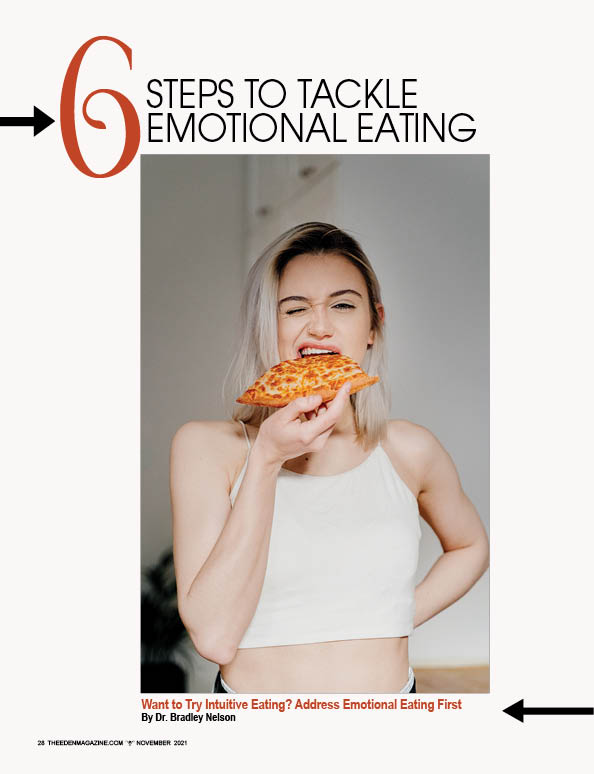By Dr. Bradley Nelson
Emotions influence our eating behaviors in complex and subtle ways, and emotional eating is linked to obesity, research has found. Dr. Brad discusses why it is so important for people to address emotional eating, and how it relates to intuitive eating.
Intuitive eating involves people learning to listen to their bodies to decide what, when and how much to eat. This is something Dr. Brad teaches people to do — but only after they have addressed the emotional triggers behind their eating. So why do people need to address the underlying reasons why they eat before they try intuitive eating?
“Human society is programmed to eat for a huge variety of non-nutritive reasons. We eat for fun. We eat to socialize. We eat because the TV is on. We eat because the clock says it’s time. And for a lot of us, we eat to subconsciously — or even consciously — medicate our emotions,” Dr. Brad says.
In recent years, there has been a lot of talk about intuitive eating. Advocates and experts hail this way of eating as a “revolutionary anti-diet” because it doesn’t involve restricting what, when, and how much we eat. Instead, intuitive eaters simply listen to their bodies on those decisions.
Sounds appealing, doesn’t it? What could be simpler than getting in touch with your body’s desire for healthy food and using that information to guide your eating choices?
Unfortunately, as anyone who has tried and failed at any kind of intuitive eating plan can tell you, it can be difficult to distinguish what our bodies truly need nutritionally when emotions and habits cloud our choices. Human society has programmed us to eat for a huge variety of non-nutritive reasons. We eat for fun. We eat to socialize. We eat because the TV is on. We eat because the clock says it’s time. And for a lot of us, we eat subconsciously — or even consciously — to medicate our emotions.
Emotions influence our eating habits in complex and subtle ways. We may eat when we’re sad, frustrated, disappointed, stressed, anxious, or angry. Anytime we allow our emotions to drive our eating, that interferes with our ability to eat intuitively. For instance, when we seek comfort in food, the foods we choose are unlikely to be the ones our bodies nutritionally need. For many people, “comfort food” is food that is loaded with fat, sugar, or extra calories. Also, when emotions drive our eating, this impedes our ability to sense when we are full and stop eating. These are some of the reasons emotional eating can lead to overeating and obesity.
In many ways, emotional eating is the opposite of intuitive eating. This is why it is important to address underlying emotions that drive why, what, and how much we eat before trying intuitive eating. Otherwise, we may ignore when our bodies are craving healthy foods such as vitamin-packed fresh vegetables and fruits and grab a slice of cake, pizza, or a toaster pastry instead. Then what do we feel? Guilt — another negative emotion that may reinforce the cycle of emotional eating. When we repeatedly engage in this kind of eating, we forget how great our body feels after eating healthy food. Yet this is one of the physical sensations successful intuitive eaters use to reinforce good habits.
Address Emotional Eating First If these emotional eating habits sound familiar, don’t despair. You can assess whether you have any tendency to eat emotionally and take steps to address those tendencies.
Start by reviewing your current eating patterns and your relationship with food. Do you ever find yourself habitually eating at certain times of the day or eating certain foods during certain events or activities? For example, do you have a snack every night before you go to bed? Is that something you had every night as a child? Is it due to physical hunger or to habit? When we eat out of habit, we override the signals our body sends that tell us if we are truly hungry or not, and we eat whether our body really needs it.
Learning to identify habitual eating is a good first step toward making more conscious and healthy eating choices. Here are some additional suggestions to help you tackle emotional eating so you can free yourself to start eating more intuitively:
1. “This Too Shall Pass.” If you can resist the urge to eat for even 15 minutes, the feelings that are driving you to crave something might subside. At that point, you can decide if you’re physically hungry or eating for some other reason.
2. Keep a Food Diary. Keep a special notebook to write down what you eat, how much, and how you’re feeling while you’re eating. Note how hungry your body is. This can help you identify triggers and create an awareness of why you’re eating.
3. Create New Habits. Instead of going for the chips when a family member yells at you or just because you’re bored, try doing something else that actually makes you feel better. Go for a walk. Read a book. Write in your journal. Any of these activities can help make you feel better without the inevitable guilt that comes from emotion-driven eating.
4. Manage Stress. Stress is a common driver of emotional eating, but there are many more productive ways to handle it. Try some yoga, deep breathing exercises, or meditation. Keeping your stress level manageable can help you avoid emotional eating.
5. Don’t Punish Yourself. It may be tempting to punish yourself with deprivation when you’ve eaten emotionally. But that usually backfires into a cycle of emotional eating. Instead of depriving yourself or dieting, eat foods that offer real satisfaction and nutrition. Your body may respond with a happier outlook that helps you eat more intuitively.
6. Release Trapped Emotions. Trapped Emotions are unresolved feelings from troubling and traumatic events that could cause you to eat when you don’t really need to. Until these negative energies are released, you might find yourself in a perpetual cycle of emotional eating. Try using The Emotion Code® to identify and release these emotions. This might be your best defense against emotional eating.
Part of The Emotion Code involves using muscle testing to get in touch with your subconscious. Muscle testing allows you to ask your subconscious yes or no questions about what your body really needs nutritionally, which can help you overcome your tendency to eat habitually or emotionally. Perhaps you feel like eating a piece of cake when your body is really craving the sweetness of a peach or banana. You can also use muscle testing to help identify and release emotional baggage that may be triggering unhealthy eating habits.
Mastering your emotions can help you clear a major barrier to learning how to eat intuitively. Then you can build healthy new habits, so your body can get what it really needs when it really needs it.







